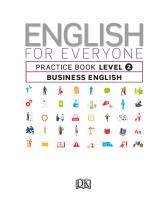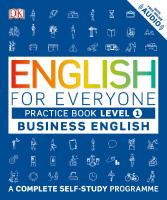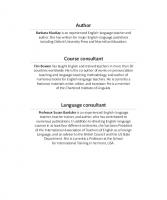Suitable for Junior Middle Level - English
131 16 17MB
English Pages 221 Year 2018
Recommend Papers

- Author / Uploaded
- Leong Chooi Fong
- Tan Hoay Khim
- Yee Teck Nyiap
- Lam You Kum
File loading please wait...
Citation preview
Malaysian Independent Chinese Secondary School Working Conunittee (M1CSS)
Suitable for Junior Middle Level
English Junior Middle 3 (Revised) Administrative Editor: Leong Chooi Fong
Interior Designer: Tan Hoay Khim Cover Designer: Ycc Tcck Nyiap
Typesetter: Lam You Kum niustrator: Ycc Teck Nyiap
© Dong Zong ITak cipta terpelihara. Mana-mana bahan atau bahagian dalam buku ini tidak dibmarkan diterbitkan semula, diximpan dalam cam yang boleh dipergunakan lagi, atau ditukar kepada apa-apa berituk atau apa-apa cam, baik dengan elektnmik. nwkanikal, k)tokopi, rakaman, pengalihan bahasa dan sebagainya tanpu mendapat kebenaran secara menulis daripada pihak penerbil lerlebih dLihulu.
© Dong Zong All rights reserved. No part of ihis publication may be reproduced, stored in a retrieval system, translated in any other languages, or tninjimitied, in any fbrm or by any means, electronic, mechanical, photocopying, recording or otherwise, without the prior written permission of the publisher.
Compiled by: 董教总华文独中「•委会统一课程委员会 Unified Curriculum Committee of Malaysian Independent Cliinese Secondary School Working Committee (MICSS )
Published & Distributed by: 马来西亚华校董事联合会总会(董总) United Chinese School Committees' Association of Malaysia ( Dong Zong) Blok A, Lot 5, Seksyen 10, Jalan Bukit, 43000 Kajang, Selangor Darul Ehsan, Malaysia. Tel :603-87362337 Fax:603-87362779 Website: www.dongzong.my Email: [email protected]
Printed by: Percetakan Advanco Sdn. Bhd.
Order of Edition: First published September 2010 Revised First edition September 2018
Authors
(arranged in alphabetical order)
Chin Fui Chung Lim Eng Sze Teo Hwa Ling Editor
Lye Che Yee
AekmAdfed堂me陶 This work is a concerted effort of various individuals, in particular, the committee members of the Editorial Board and teachers (reviewers)
who have provided valuable suggestions and proofread the manuscript. We would like to extend our sincere thanks to the advisor, Dr Lim Ho Peng and the Committee Members (in alphabetical order), Chong Siew Choo, D. Neelambikai, Kuan Boh Leng, Lee Soo Chee, Lim Tat Foo, Mabil Pereira, Ong Siew Lian, Tan Yik Wah and Tung Yan Yan and all
concerned for their contributions to the English Junior Middle 3.
1. The contents of the English Junior Middle series follow closely the Unified Curriculum prepared by the Curriculum Department of the United Chinese School Committees' Association of Malaysia (Dong Zong).
2. The series are specially written for the students of Malaysian Independent Chinese Secondary Schools (MICSS). There are 3 books in the series, which are written for Junior Middle 1, 2 and
3 students.
3. Each book is divided into 12 units: 10 units of the lessons are theme-based and 2 units are reviews. Each unit (except Units 6 and 12) consists of 7 sections: listening, speaking, reading, writing, language, sound system and enrichment. • Listening. The listening materials contain examples of formal and informal English. The exercises are progressively controlled in length and difficulty.
• Speaking. A variety of oral practices are provided to ensure motivating and enjoyable lessons. These activities include role-plays, conversations and discussions. • Reading. Each unit includes a reading passage. Various comprehension exercises are set on each reading passage. The
use of illustrations helps to stimulate * students interest and provides a visual context to enhance * students understanding. • Writing. The exercises in this section enable students to write coherently and cohesively about the issues and topics found in each unit. Writing exercises are varied and various writing skills, such as giving directions, personal description etc. can be developed. Besides that, summary writing activities are also included in this section so as to expose students to summarising skills.
• Language. The grammar exercises have been carefully planned to ensure that every item of the syllabus is covered. Various types of exercises are provided for the students to practise and enhance their language skills. • Sound System. Every unit includes a pronunciation practice
to help students differentiate between vowels and consonants and speak with proper stress and intonation. • Enrichment. This section focuses on the words and
expressions for students at this level.
4. The series are tailored for the weekly 6 times 40-minute lessons. However, teachers are encouraged to adapt or add to the activities in the textbooks based on the teaching-learning context. 5. Each of the series contains an audio CD for listening activities. 6. A Teacher's Guide is available for each of the series. 7. We welcome any feedback from teachers and readers in helping
to improve future editions of the series.
Contents Unit/Topic
Unitl Festivals
1-18
Unit 2 Computers
19-36
Listening
• •
• •
•
Unit 3 Community Service
37-58
Unit 4 Wildlife Conservation
•
• •
59-80
Speaking
Sharing of opinions about different festivals Describing festivals in your country
•
Two people talking about computers A discussion on computer hackers
•
A volunteer sharing his experience in doing community service Talking about the community services available in your country
•
•
• • •
Asking for and providing specific information Describing festivals
Discussing the computer and its contributions to the modern world Expressing opinions
Talking about experiences in community service Giving opinions Giving specific information
A talk on wildlife conservation A discussion on wildlife conservation projects being carried out in your country
•
•
Talking about wildlife conservation and its importance Asking for and providing specific information Expressing opinion
Poems recital An interview with a poet
• •
Discussing simple poems Discussing images in poems
•
Reading
Festivals
Computer
Community Service
Wildlife Conservation
Unit 5 Poems
81-98
• •
Poem
Unit6 Review
—
Review
—
99-108
Unit 7 Societies and Clubs
109-126
• •
A conversation about societies and clubs A talk on the benefits of co-curricular activities
• •
Talking about societies and clubs Expressing likes and dislikes
Societies and Clubs: History of the International Red Cross and Its Work Today
Writing
Language
•
Articles •
•
Sentences, Clauses and Phrases •
Writing an informal letter to a friend Summary Writing
Writing an essay about the advantages and disadvantages using computer Summary Writing
Sound System • •
• •
•
Compound Words
/ei/ and Zai/ Sounds Intonation: Expressing Certainty or Doubt
Tongue Twisters
/ei/, /ai/ and /oi/ Sounds Intonation: Expressing Certainty and Surprise Using 4Musf and Can't'
Comics
•
• /u/ and /u:/ Sounds • Stress Patterns (Sentences)
Hangman
•
Writing an essay about the importance of wildlife conservation Summary Writing
• • •
Writing a simple poem Sharing the poem in class Summary Writing
• /n/ and /q/ Sounds • Intonation: Asking Factual Questions
Newspaper In Education
•
-The Active and Passive Voice -Direct and Indirect speech
•
Review
/u:/ and /us/ Sounds Intonation: Contradicting
Writing an essay about the benefits of community service Summary Writing
-Noun, Adjectival and Adverbial Phrases -Noun, Adjectival and Adverbial Clauses
The Present Perfect Continuous Tense
Enrichment
•
Review
•
The Past Perfect Continuous Tense •
Outlining and writing an essay on the benefits of cocurricular activities Summary Writing
—
• •
/au/ and /eu/ Sounds Stress Patterns (Sentences)
—
British and American English
•
Unit 8
Architecture
•
127-146
Unit 9
Tourism
• •
147-166
Unit 10
•
Superstitions
167-184
•
•
Unit 11
Part-time Jobs
185-204
Speaking
Listening
Unit/Topic
•
An interview with an architect about his works Talking about the significant buildings in your country
A conversation on types of tourism in Malaysia A tour guide talking about his profession and experience.
A dialogue on beliefs and superstitions in different countries Two people telling superstitious stories
An interview between a manager and an applicant for a part-time job A newspaper report on students* working parttime
• •
• •
•
•
• •
Reading
Discussing the cultural influences on buildings Describing buildings
Architecture
Talking about famous tourist destinations around the worid Describing places
Tourism
Expressing comparison and contrast of different beliefs and superstitions Expressing doubt
Talking about working parttime Expressing dissatisfaction / Td complain
Superstitions
Part-time Jobs
Unit 12
Review
205-212
CD Script
i-xviii
—
Review
—
Writing
Language
Conjunctions: and, but, or, both...and, either...or, neither... nor, not only...but (also)
Sound System •
• •
Describing a building Summary Writing
•
• •
Modal Verbs •
•
'If Clauses •
• •
Prepositions Phrasal Verbs
Review
• •
Writing an essay about places of interest Summary Writing
Writing a story based on superstitions Summary Writing
Writing an application letter for a part-time job Summary Writing
Review
•
/ie/ and /ea/ Sounds Intonation: Making Questions out of Statements /0/ and /d/ Sounds Intonation: Showing Contrast
Enrichment
Suffixes and Prefixes
Contrary Proverbs and Proverb Humour
• M and /w/ •
• •
Sounds Intonation with Stress
/3/ Sound Intonation: Responding to Requests or Questions
—
Common Errors in English
Prepositions: Phrasal Verbs
—
Unitl - Celebrations of Festivals -Articles
- /u:/ and /s/ Sounds - Intonation: Contradicting
- Compound Words
What are the festivals celebrated in your country?
How do you celebrate these festivals?
A
1. Wen Han, Daud and Frank are talking about different festivals. Listen to their conversation.
2. Listen to the conversation again and then fill in the speech bubbles below with the help of a friend. Hari Raya Puasa
Chinese New Year -Frank often sees ⑴
-This festival is celebrated by ⑷
-They are members of (2)_________________ ,
-They have to ⑸
-They are going to (3)
Thanksgiving
-This day is a ⑻ in (9)
-They need (6) and [7]_____
to be able to do it.
-On this day, people (10)
-It's a tradition to (11)
■cl ,Festivals like Hari Raya, ;Christmas and Deepavali : are religious events. . However, there are R also festivals
which are
not religiously related, such as the Cannes Film Festival or the Rainforest Worid Music Festival in Sarawak.
5
7. Listen to the descriptions of the different celebrations given by Su Yee, Najendran and Nanako.
2. Listen to the descriptions again and fill in the blanks with suitable words. Description A
Su Yee is excited because XI)___________________is coming soon. She helps her mother to (2)such as love letters and (3). Last
week, she also went shopping with her family and 0)because red signifies prosperity. She likes to (5)because she believes
the more,ang pows5 she receives, the more (6).
Description B Nanjendran and his family XZ)_______________ Ponggal. Ponggal is a festival celebrated
by (S). The festival is celebrated _(2)_____________________ for a good harvest. They will prepare (10)for the festival.
The rice is mixed with (11)and then cooked in a clay pot (12). Najendran and his family members will gather around
the pot in a circle and wait for the milk in the pot (13). He likes to celebrate Ponggal because he gets to (14).
Description C
Nanako is a Japanese and she celebrates the (15). This
festival falls in the month of August. The Japanese celebrate this festival in memory of (16). They dance the 'Bon Odori, which actually means the 'Bon' dance in Japanese. During the 'Bon' week, they wear their Yukata, which is their
(17)and gather on the field to dance to Japanese (18)
3
A
Expressions Asking for and Providing Specific Information What
kind of festival do you do
do you celebrate? during_______________________ ?
When
is
____________________ celebrated?
do you
celebrate_____________________ ?
will
you visit your_________________ ? you go to_____________________ ?
I My family and I
celebrate
visit
friends and____________________ .
bake
cookies and____________________ .
will
visit friends____________________ . go to the__________________ later.
To add additional information, you may use these words. • too - Janet likes reading. She likes travelling too. • also - Ali has been to Japan. He has also visited Korea. • as well - My friends are coming to my house. My teacher will visit me as well.
2
B Read and understand the description below.
Description Hello, I am Gurnawan. Like everyone living in Bali, Indonesia, I celebrate the Galungan festival. The Galungan festival is a celebration ofgood over evil and it is the most important festival in Bali. During the festival, we put towering bamboo poles outside our house gates. Festive dishes like rice cakes are prepared a day before Galungan. On Galungan, Balinese will dress in their most exquisite traditional costumes and give offerings and prayers.
C
Choose any of the pictures below and describe the festival with the help of the clues given. You may 尸次厂 to the description on page 4.
-Wesak Day -Buddhists -The Bathing Buddha ceremony -Offerings and Prayers at temples
-Hari Raya Qurban -Muslims -Pilgrimage to Mecca -Sacrifice cows
-Mid Autumn Festival -Moon cakes -Lantern -The 8th Month of Chinese Lunar Calendar
-Thaipusam -Procession to temples -Milk offerings -Batu Caves
奥Ete史^加饰
-Deepavali -Hindus -Festival of Lights -Prayers
-Christmas -Christians -Birth of Jesus Christ -Church
冷*
Ifyou could create your very own imaginary festival, what kind offestival would you create and 力ow would the festival be celebrated? Discuss with your partner and present your ideas to the class.
A
Read the following letter. 5-2-1, Ginza Chuo-ku, Tokyo 170-3293. 20 September 20—
Dear Kar Poh, Hi! I hope that you and your family are in the pink of health. In your recent letter, you asked me to share with you some festivals celebrated in Japan. Well, let me tell you about one of the festivals (or 'matsuri' in Japanese) celebrated here. 'Shogatsu' (Japanese New Year) is the most important and elaborate festival. 'Shogatsu' is celebrated between the 1st and 3rd of January annually. Preparations start on 13 December. We clean our homes thoroughly.4 Shimenawa, (a sacred rope of straw) with dangling 'shide' (white paper strips) is hung over our front door to prevent the evil spirits from entering our house and to showthepresence of4 toshigami5 (our rfez^pofthe forthcoming year). Furthermore, 'osechi' (food in trays) are bought and prepared. These preparations are done to welcome 'toshigami' to our homes. You might wonder why we prepare 'osechi'. Well, 'osechi' is a must as this traditional food comes in different lucky colours, shapes and auspicious names. We hope that 'osechi' will bring good tidings to our life throughout the year. We also keep vigil and eat soba noodles at midnight. Do you have a similar practice during your new year?
'Shogatsu' is celebrated with family gatherings and visits to Buddhist temples or Shinto shrines. Nevertheless, we usually spend the first day with our family members. On the second and third days, we visit our relatives and friends. The streets are filled with 'matsuri' stalls selling souvenirs and food such as 'taroyaki', and games like goldfish scooping, sumo matches and other forms of entertainment are often held. We also play games such as 'tako age' (kite flying), 'komamawashi' (spinning tops) and 'karuta' (a card game) to bring good luck for the year. Apart from exchanging greeting cards, totoshidama, (special allowance) is given to children. When I was younger, this was my favourite moment because I could collect a lot of money. Well, I need to pen off now. I hope that one day you can visit and celebrate 'Shogatsu' with me. Write to me soon and tell me more about your Malaysian festivals. Take care and 'sayonara'! Your friend, Moriyama
^33^^ shrines - a place of worship pen off - stop writing ^ayonara* - Japanese word for*goodbye'
B
The following words arefound in the passage. Match the words in Column A with their meanings in Column B. Column B
Column A
1.
elaborate
*
*
hanging
2.
sacred
*
*
holy places that people go to pray
3.
dangling
*
*
detailed
4.
deity
*
*
news
5.
tidings
*
*
holy
6.
shrines
*
*
god or goddess
7
C Fill in the blanks with the correct words from Column A in Exercise B. 1.
She 1 汰es to wear
2.
When they were in India, they visited some ancient Hindu.
3.
The project involves a very it on time.
4.
Certain animals were considered actually prayed to these animals.
5.
The family experienced a string ofbad luck last year. As the new year was approaching, they hoped it would bring them good.
6.
All of them gave some offerings to their
earrings.
process, so we may not be able to complete
by some tribes in the past. They
at the temple yesterday.
D For each statement below, write 7' if the statement is true and 'F' if it is false. 1.
The main reason Moriyama wrote the letter is to ask Kar Poh to tell him about the festivals in Malaysia.
2.
'Shogatsu' is a type of Japanese noodles
3.
The Japanese usually start the new year preparation on 13 December.
4.
'Taroyaki' is a must for every Japanese household during 'Shogatsu'.
5.
The Japanese will usually spend the first day of the year with their family members.
6.
Moriyama's favourite moment of 'Shogatsu' was receiving 'otoshidama'.
E
Circle the best answerfrom the options provided. 1.
What does the phrase 'in the pink of health5 in paragraph 1 mean? A the colour of health B the worst of health C the best of health D the joy of health
2.
When is
![Suitable for Junior Middle Level - English [13 ed.]](https://ebin.pub/img/200x200/suitable-for-junior-middle-level-english-13nbsped.jpg)
![Suitable for Junior Middle Level - English [10 ed.]](https://ebin.pub/img/200x200/suitable-for-junior-middle-level-english-10nbsped.jpg)







